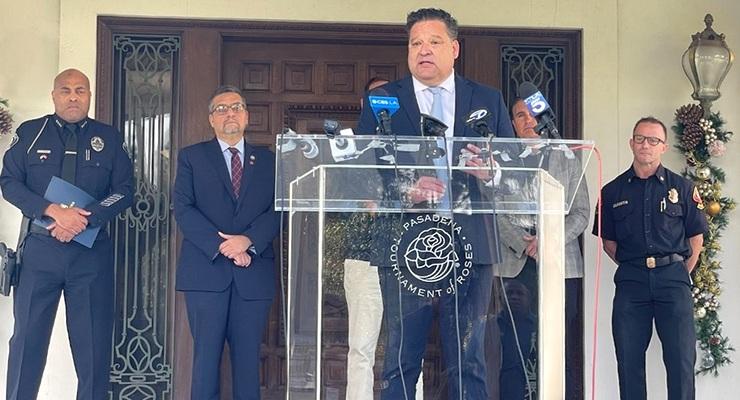
Pasadena’s much-discussed $2.4 billion Capital Improvement Program (CIP) represents a five-year strategic roadmap for infrastructure investment, not an immediate funding crisis, city officials clarified during a joint City Council and Finance Committee meeting.
The plan includes 218 projects with $446 million recommended for the current fiscal year to address critical needs across multiple departments.
“The CIP budget is a five-year strategic planning document outlining long-term investment needs for the city’s infrastructure,” explained Greg de Vinck, Public Works Director. “It serves as a roadmap for identifying, prioritizing, and funding capital projects, all consistent with the city’s general plan.”
The comprehensive budget breakdown reveals that approximately $880 million has already been appropriated, leaving an unfunded balance of $1.1 billion in the current plan, plus an additional 48 future unfunded projects estimated at $430 million.
“The development and adoption of the 5-Year Capital Improvement Plan each year is an important step in our annual budget process to approve and fund projects,” said Finance Director Matthrew Hawkesworth. “We recognize that including unfunded or underfunded projects can appear unusual; however, it’s critical for the City to have these approved projects in the Plan when seeking outside funding sources such as grants and congressional discretionary spending, as most outside agencies will not consider funding a project that is not active and approved.”
Hawkesworth also said the Capital Improvement Plan is a fluid document that can and is changed by the City Council throughout the year as new funds become available, funding requirements change, projects close out, or new projects arise.
When excluding the Central Library project, Water and Power account for 73% of the funding distribution, operating companies represent 13%, and remaining city infrastructure (buildings, streets, lighting, transportation) makes up 15%.
Most CIP funding comes from restricted sources, with utility ratepayer money and dedicated funds comprising a large part of the budget. Only a quarter of one percent comes from discretionary general fund dollars, creating challenges for addressing needs like street repairs.
Street conditions emerged as a focal point during budget discussions. The city’s Pavement Condition Index (PCI) currently stands at approximately 59-60, up slightly from 53 a few years ago but still below acceptable standards.
“Street paving is a top three concern, affecting everyone and being obviously bad due to decades of underfunding,” de Vinck acknowledged. “The current council is aware and has committed more money.”
The proposed street resurfacing budget includes $5.9 million from gas tax, RMRA funds, and sewer fund, with the potential for an additional $5 million from the general fund, similar to allocations in the past two years.
Data presented by Public Works showed that $11 million in annual funding could raise the PCI to 63-64 over five years, while the baseline $5.9 million would keep the PCI stagnant or cause it to drop further.
“If I had $75 million today, we would be saving millions of dollars,” de Vinck said, acknowledging that delaying repairs increases costs over time.
Despite funding limitations, the city has made significant progress on infrastructure projects in the past year. Recent accomplishments include improvements to Arroyo Trail, accessible bathrooms at the Villa Park Community Center, and pickleball courts at Vina Viejo Park. Public Works completed 65,000 square feet of sidewalk replacements, resurfaced 17 miles of streets, installed 75 new ADA ramps, and performed extensive sewer line maintenance.
The Transportation Department has successfully secured external funding, with grants covering 91% of its $278 million in projects. Transportation initiatives focus on traffic calming (40% of projects), transit improvements, and transitioning to zero-emission vehicles.
Councilmembers debated various funding approaches, including potentially using reserve funds for critical infrastructure. Councilmember Jason Lyon suggested that reaching good streets would require significant investment and expressed concern about the current funding level.
“I think this is a place where the reserve is there. It’s the people’s money and it’s there for critical needs,” Lyon said.
Mayor Victor Gordo expressed caution about using reserve funds for ongoing needs. “I’d be reluctant to spend one-time reserve dollars,” Gordo said. “I’ve seen recessions, housing crisis, you name it, and fires where those reserves have come in very handy.”
Councilmember Rick Cole highlighted the scope of the challenge.
“We have a $2 billion shortfall of capital,” Cole said. “We need to have a very serious conversation about how we’re going to pay for $2 billion worth of needs in this community.”
January’s Eaton Fire has influenced infrastructure priorities, particularly in regards to undergrounding utilities and system resilience.
“All of the tier three areas, which are the extreme fire risks, those are all going to have their high voltage lines undergrounded,” said David Reyes, interim general manager for Water and Power.
Several residents urged greater focus on climate initiatives, particularly local solar projects, following the city’s 2023 climate emergency resolution. The budget includes $13.5 million for energy storage in FY26, supporting carbon-free electricity goals.
“Climate change presents an existential threat to our community, and Pasadena must do everything possible to reduce greenhouse gas emissions and transition away from fossil fuels,” Cynthia Cannady wrote in correspondence to the City Council. “Electrifying homes and expanding access to solar energy are critical components of this effort.”
The Rose Bowl Operating Company detailed approximately $200 million in facility needs over the next 20 years, with critical assets requiring $3 to $6 million annually over the next five years.
The final CIP budget is scheduled for adoption on May 5 following a public hearing process that began on April 14.



















